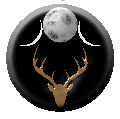
SYLVAN

WICCA /SHAMANISM
LESSON 12
Lesson Twelve: Sabbats
Homework: Before beginning this lesson,
read The Sabbats: Part I and The
Sabbats: Part IIAs we look at the Sabbats, we find we have eight magickal days which
divide the solar
year. Beginning with Winter Solstice (when the sun is symbolically born,
represented in
the growing hours of daylight in the natural world and the birth of the
Oak King in the
divine myth) the energy of the solar cycle waxes and wanes throughout the
solar a
year.Modern Witches often refer to this cycle as The Wheel of the Year
and the
changing seasons are often labeled, "The turning of the Wheel."
To understand the Sabbats fully, we need not to just understand why we
celebrate
them (The Sabbats: Part I) or even the modern Traditions associated with
them (The
Sabbats: Part II). Both of these concepts are important pieces of the
puzzle, but they are
only a small part of the overall picture. Like much of what we've covered
in this guide,
we're interested in energy, in the application of the magick of these
days, and in how we
can add this sacred site to our personal tool box of magickal tools.
One of the difficult things about teaching the Sabbats to a wide audience
is, much like
the naming of the moons, learning how to apply the Sabbats where you live
is based on
environmental factors. I didn't come to discover this issue until a
couple of years ago
when I was discussing magickal theory with a Los Angeles based Wiccan. We
were
discussing the shifting of energy in the Wheel of the Year and how it was
tied to the
changing energy of the seasons. She informed me that Southern California
has fairly
static seasons; one day is much like the next. And for my friends in the
Southern
Hemisphere, the symbolism of the Sabbats is reversed. While we're
celebrating Winter
Solstice in the Pacific Northwest, their in the middle of their summer.
So you will need to
adjust the concepts that you use to celebrate the Sabbats according to the
environmental factors in the area you live.
While Esbats are usually (but not always) celebrated at night, I teach
that four of the
Sabbats (the Solstices and Equinoxes) are most appropriately observed at
sunrise. And here's why.
In our modern world, we often think of the Solstice and Equinox Sabbats
as being days
when the hours of sunlight are at their greatest extremes (Solstices) or
when the hours
of daylight and darkness are equal (Equinoxes). However, if we look back
to our
homework, we find that the magick of these days isn't found by using a
stop watch to
determine how many hours of sunlight we experience, but in the journey of
the sun as it
peaks over the horizon. It's at that moment, when the sun begins to
appear in our world,
when the heralding light predawn is joined by the fiery orb of our
closest star, that the magick is born into our world.
While we have no way of being certain, it was most likely these four days
that gave birth
to our modern Sabbats. Determining the days of the Cross-Quarter Sabbats
(non-Solstice and non-Equinox)
takes an understanding of the concepts of astronomy, something our
Pagan ancestors may have developed in time, but something they most
likely didn't
develop until we began our shift into an agricultural society and
developed traditions and lore associated with the Pagan view of life and Nature.
When you find a Sabbat approaching and are trying to determine how you
will celebrate
it, you need to look at two factors. First of all, consider what is going
on in the natural
world. Is it a Solstice and the sun is beginning its journey once more
after stopping at it's
most distant point? Is it an Equinox where the hours of daylight and
darkness are equal?
Imbolc when the life of spring is beginning to stir? Samhain, when the
last harvest has
been gathered and the natural world begins to "die?" By applying many of
the same
techniques to the natural world that you learned to determine if
spellwork was appropriate,
you can analyze the energy around you. Once you have a handle on what is
happening in
the natural world, it is a simple task to build your ritual around the
symbolism of that energy.
The second thing you will want to consider is when the most appropriate
time to hold the
ritual falls. Is it a Solstice or Equinox when we honor the sunrise?
Samhain when our
rituals often take place in the darkest part of the night? As you begin
to look at the
symbolism behind each time of day, you may find additional inspiration in
creating your
rituals. And if you're not sure what the symbolism is, simply go through
the same process
you used to connect with the items on your altar or the various types of
energy we
studied. Simply focus on the time of day and let yourself feel what it
means to you. It's no more difficult than that.
The First Cycle course is written by Graelan Wintertide
and is © 1999 All Rights Reserved